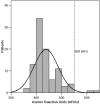Dual antiplatelet therapy monitoring for neurointerventional procedures using a point-of-care platelet function test: a single-center experience
- PMID: 18483190
- PMCID: PMC8119128
- DOI: 10.3174/ajnr.A1070
Dual antiplatelet therapy monitoring for neurointerventional procedures using a point-of-care platelet function test: a single-center experience
Abstract
Background and purpose: Growing evidence of the relationship between poor antiplatelet response and occurrence of clinical events elicited the need of monitoring the response which has not been part of our daily practice. We present our initial experience with a new point-of-care antiplatelet-function test (VerifyNow assay) in neurointerventional procedures.
Materials and methods: Among the 106 consecutive patients from July 2006 to April 2007, ninety-eight met the inclusion criteria. Our preferred antiplatelet regimen was aspirin (325 mg daily) and clopidogrel (300 mg of loading dose followed by 75 mg daily) starting 5-10 days before the procedure. The test results were reported as aspirin-reaction unit (ARU) for aspirin and P2Y(12) reaction units (PRU), baseline (BASE), and percentage inhibition for the P2Y(12) assay and were summarized as mean +/- SD of the values. We analyzed the effects of several factors of poor clopidogrel response (<40% inhibition). The occurrence of thrombotic events was recorded.
Results: The mean ARU of aspirin assays was 438.3 +/- 47.9 (range, 350-632), and the response was poor in 2 patients (2.1%). For clopidogrel, the mean of the BASE, PRU, and percentage inhibition was 356.8 +/- 56.3 (range, 234-495), 198.9 +/- 104.4 (range, 8-401), and 45.2 +/- 27.1% (range, 0-98), respectively. Forty-two patients (42.9%) showed poor response. Multivariate analysis showed greater body weight (81.9 Kg +/- 19.1 kg versus 69.9 +/- 15 kg) in the poor-response group. All 3 cases of intraprocedural thrombosis (3.1%) were observed only in the poor-response group.
Conclusion: We observed a high frequency of poor clopidogrel responses in the neurointerventional setting. Routine monitoring of the drug response would be helpful for the early identification of poor antiplatelet responders so that we may modify the regimen and/or treatment plan.
Figures




References
-
- Fiorella D, Albuquerque FC, Woo H, et al. Neuroform in-stent stenosis: incidence, natural history, and treatment strategies. Neurosurgery 2006;59:34–42 - PubMed
-
- SSYLVIA Study Investigators. Stenting of Symptomatic Atherosclerotic Lesions in the Vertebral or Intracranial Arteries (SSYLVIA): study results. Stroke 2004;35:1388–92. Epub 2004 Apr 22. - PubMed
-
- Ries T, Buhk JH, Kucinski T, et al. Intravenous administration of acetylsalicylic acid during endovascular treatment of cerebral aneurysms reduces the rate of thromboembolic events. Stroke 2006;37:1816–21 - PubMed
-
- Grunwald IQ, Papanagiotou P, Politi M, et al. Endovascular treatment of unruptured intracranial aneurysms: occurrence of thromboembolic events. Neurosurgery 2006;58:612–18 - PubMed
MeSH terms
Substances
LinkOut - more resources
Full Text Sources
Medical
Miscellaneous
